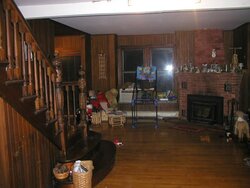Wow you guys are replying faster than I can respond! This is great!
Follow up to a few responses:
Yes I have a 3 story home because the basement (1st floor) is above ground level. I have 10' ceilings on the 2nd floor (main floor) and 12' ceilings on the 3rd floor. So, yes the chimney is very tall. It extends about 10' higher than my rooftop. Its possibly less than 40' because im guessing. However its pretty close to my guess.
What I mean by this "My air deflector plates/channels on the insert had large gaps at all seems. I sealed all of them off with steel duct tape" is the blower pushes air around the exterior of the box and the the air is channeled through these ducts which I reffered to as deflector plates or channels.
What I meant by this "The insert is installed with the 5” of finished fascia pulled out and the sides are blocked off with the iron faceplate" is the insert is sticking out about 5" forward of the faceplate. This is how its was designed to be because any further out and it would not mate to the faceplate anymore because it tapers down smaller past the first 5".
Voltage to the blower is 126v and there is no hi-low switch that Ive seen.
The insert doest have a heat sensing switch that turns on the blower at 180 deg. It does come on as it should.
My dealer told me it would easily heat 2000 sq ft. I have not tried any fans to distribute the heat because I dont think it makes enough heat. If I stand at the bottom of my stairwell (see picture) I can just barely feel the temp difference (a little higher) and thats only 10'. I think if I started dispensing the heat out further it would then not be felt anywhere.
Follow up to a few responses:
Yes I have a 3 story home because the basement (1st floor) is above ground level. I have 10' ceilings on the 2nd floor (main floor) and 12' ceilings on the 3rd floor. So, yes the chimney is very tall. It extends about 10' higher than my rooftop. Its possibly less than 40' because im guessing. However its pretty close to my guess.
What I mean by this "My air deflector plates/channels on the insert had large gaps at all seems. I sealed all of them off with steel duct tape" is the blower pushes air around the exterior of the box and the the air is channeled through these ducts which I reffered to as deflector plates or channels.
What I meant by this "The insert is installed with the 5” of finished fascia pulled out and the sides are blocked off with the iron faceplate" is the insert is sticking out about 5" forward of the faceplate. This is how its was designed to be because any further out and it would not mate to the faceplate anymore because it tapers down smaller past the first 5".
Voltage to the blower is 126v and there is no hi-low switch that Ive seen.
The insert doest have a heat sensing switch that turns on the blower at 180 deg. It does come on as it should.
My dealer told me it would easily heat 2000 sq ft. I have not tried any fans to distribute the heat because I dont think it makes enough heat. If I stand at the bottom of my stairwell (see picture) I can just barely feel the temp difference (a little higher) and thats only 10'. I think if I started dispensing the heat out further it would then not be felt anywhere.


